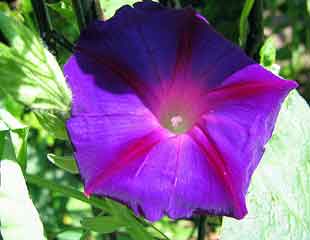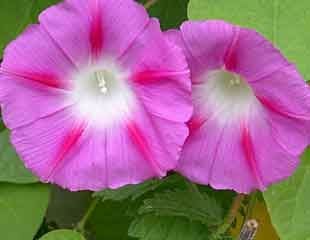How to grow Ipomoea Morning Glory Plant

Ipomoea is a tender, annual climbing plant with velvety saucer like blooms. As an annual, it will grow to maturity, flower and die in same year. Being tender means it needs to be protected from cold and grown in a warm sunny spot.
The common name "Morning Glory" refers to 1,000 species of flowering plants in the family Convolvulaceae. The largest group in the family, Convolvulaceae, is Ipomoea.
Ipomoea hail from warm parts of the world, which means they are sensitive to the cold, probably more so than most tender plants gardeners commonly encounter. If, after germination, the young plants get so much as a chill breeze, the leaves will wither and the plants suffer. It is true to say during poor summers, or in more exposed gardens, it may be a struggle to establish Ipomoea and to get them to flower well.
But, that said, Morning glory is easy to germinate and grow provided always they are kept warm. Besides the blue variety of Ipomoea purpurea, seed companies sell a much wider range of colours. There is also a pure white variety which only opens its bloom at night. The flowers are fragile, very pale and scented, illustrated above.
There is also a variety of Ipomoea which has red and yellow flowers, called Ipomoea lobata also known as the Spanish flag plant. In common with all Ipomoeas it is tender and has the same warm growing requirements. However, it's flowers are a different shape and it tends to be more leafy.
Morning Glory is vigorous and flowers best in warm summers, and in the warmer, more sheltered parts of the UK. Ipomoea is a captivating climber, which is why I try to grow each year in the hope of a good summer. Impossible to resist.
How to Grow Ipomoea Morning Glory from Seed
Ipomoea is an H1 plant; this means it's very tender and needs warmth throughout its life cycle, beginning with germination.
To germinate, put seeds in a small seed tray/container cover lightly with compost, firm down gently and mist. Ipomoea are best germinated in a propagator, or covered and once germinated, keep warm and do not allow to dry out. Some gardeners recommend Pre-soaking the seeds. I find the seeds germinate fine without this, but if you are having a problem, it is worth a try. Soak the seeds for up to 3 hours in warm water and then sow straight away. A temperature of 18C is required to trigger germination.
Do not be tempted to keep the seedlings in the propagator because the warm, moist atmosphere will make the seedlings too soft and sappy. Equally, unless you are germinating late in the year, an unheated greenhouse will not be warm enough. The seedlings need to be nurtured inside on a windowsill or a warm conservatory. If you have nowhere warm to keep the plants, delay germination until May.
How and when to plant Ipomoea
Only plant Ipomoea outside when the plants are sturdy, all risk of frost has passed, and the weather is warm. Plant in a sheltered spot with plenty of sun. Ipomoea are not particular about the type of soil and will tolerate quite poor soils. Unless you are in a sheltered spot, don't plant out until June when it is warmer. If you get caught out, cover with a fleece to protect from cold.
Once established, in warm enough conditions, Ipomoea requires no maintenance or attention.
Ipomoea is a climbing plant which will naturally climb, and an ideal place is alongside a south-facing wall with a trellis or support to climb up. The wall will provide plenty of heat.
Growing Morning Glory Key Points

Level of difficulty : Red Wheelbarrow
Classification: Annual Climber
Conditions Required: Sheltered warm sunny special requirements: Very frost tender.
.



